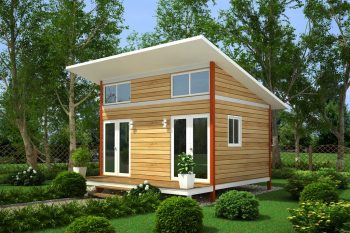Contributing writer for Wake Up World
“Living small isn’t solely about counting up your stuff or living in a little house. It’s about making time for family, doing work you love, and building community.” ~ Rowdy Kittens.com
As a child, I remember visiting my grandmother’s house in the San Francisco Bay Area, the same place my dad grew up. It was a tiny, three bedroom cottage with one bathroom, along with a small common area and minuscule kitchen that barely fit two people at a time. I was astounded to learn that my three aunts had to share a room, as did my dad and his brother. Our childhood house seemed massive in comparison.
My sister and I each had our own, large room. Plus there were three full bathrooms, a living room, dining room, den and family room, as well as a huge backyard. Our kitchen could fit ten people, easily. What I didn’t realize at the time is that my dad’s house was very typical for the time — average middle class people really didn’t build large houses in those days. It wasn’t about show or status, but simply living within your means.
[pro_ad_display_adzone id=”110028″]
Jump to the present and we’re seeing a similar orientation following the banking crisis, recession and flood of young people who are facing a bleak job market, even with top-notch college degrees. People are scaling down and taking back their lives, opting for smaller houses so they can live big without slaving away at 80-hour work weeks.
On one end of this trend is the tiny house movement, where people are ditching mortgages altogether and the accumulation of stuff to instead live a scaled-back life in specially-designed small spaces — 500 feet or less.
Proponents of tiny house living say not only do they have financial freedom and more time to do what they love, but they’re also treading lightly on the earth, using less resources and space. In short, it’s both eco-friendly and fun. A win-win.
The Changing Landscape of American Housing
In the 1900s, a typical American home had 700 to 1,200 square feet of living space, with two or three small bedrooms and one, or more likely no, bathrooms. Two-story structures were common.
At the turn of the 20th century, a large percentage of Americans (more than 20 percent) lived in cramped housing, with entire families sharing one, maybe two, rooms. A majority of homes were small, rural farmhouses without basic amenities — like plumbing and central heating.
Throughout the nation, we can still see pockets of small cottages built in the 1930s and 1940s. By the 1950s, the average new home hadn’t grown in size, it still was around 1,000 square feet, with just two bedrooms and one bath. The houses tended to be a single-story design. One of the first suburbs in America — Levittown, New York — designed and built houses around 750 square feet.
However, we’ve seen a monumental change in American housing over the last half century. By the year 2000, a typical new home had 2,000+ square feet, three or more bedrooms and at least 2.5 baths. A 2-3 car garage is now standard, with fireplaces and central air conditioning the norm. Two-story designs came back into fashion. The underlying message behind these large-sized houses is that bigger is better. But over the last decade, people have been questioning this assumption and seriously downsizing. Enter the tiny house movement.
Living Big in Tiny Houses
When Macy Miller’s 2,500-square-foot Idaho home was foreclosed in 2007 after her divorce, she became enamored with the idea of scaling down her lifestyle. “I have absolutely zero interest in tying myself up with that kind of loan ever again,” she told Bloomberg. Miller is just one of many “real-estate refugees.”
By 2011, Miller had taken matters into her own hands (literally) and built herself a 196-square-foot-timber home on a trailer in Boise, Idaho. It took her 18 months to complete, for a grand total of $11,000, debt-free. She pays $200 a month to rent the land it sits on and shares the space with her partner, their baby and a 100-pound Great Dane named Denver.
Miller’s story is not uncommon as people across the nation look for creative and innovative ways to avoid being locked into large mortgages and debt — which in turn free’s up time and money, while increasing the overall quality of life. Tiny house advocates also point out that smaller spaces require less maintenance and significantly reduce time spent cleaning. Plus they use far less materials for construction compared to an average house, thereby reducing their environmental impact. Moreover, many are designed to be off-grid — with solar panels, rainwater collection systems and composting toilets.
But city zoning laws and restrictions have proven to be a formidable obstacle for many tiny homes — although this is slowly changing. Many have worked around cumbersome city codes by placing their tiny houses on trailers, which transforms them into a mobile home, as far as city officials are concerned. Others have planted their houses far in the country where governmental oversight is less of an issue. States like New Mexico and Texas are both a hotbed of tiny houses, largely because of lax building codes. And some inventive entrepreneurs are working with city planners to create posh tiny home communities that fall under the forgiving classification of a mobile home park. All in all, where there’s a will, there’s a way — and people are making it work, even in densely populated locations like Washington D.C.
If you’d like to learn more about this highly creative and fun housing movement, have a look at the documentaries below that follow one woman’s journey through the fascinating world of tiny houses and their owners.
We The Tiny House People (Documentary): Small Homes, Tiny Flats & Wee Shelters
TV producer and Internet-video personality Kirsten Dirksen invites us on her journey into the tiny homes of people searching for simplicity, self-sufficiency, minimalism and happiness by creating shelter in caves, converted garages, trailers, tool sheds, river boats and former pigeon coops.
Summer of (Family) Love: Tiny Home VW-Roadtrip
One of the most elusive goals in life is determining just what you need to live. The founders of faircompanies.com, a site on simple living, have spent the past eight years examining the unencumbered lives of others, and this summer had the opportunity to try out micro-living first-hand on a filming road trip through the Pacific Northwest…
Article sources:
- www.articles.chicagotribune.com/…1_single-family-homes-two-or-three-bedrooms-new-housing-units
- www.moyak.com/papers/house-sizes.html
- www.bloomberg.com/news/articles/2014-07-09/tiny-houses-big-with-u-s-owners-seeking-economic-freedom
- www.huffingtonpost.com/mike-salguero/the-tiny-house-movement_b_5811058.html
Recommended articles by Carolanne Wright:
- Renowned Harvard Psychologist Says ADHD is Largely a Fraud
- Hyperbaric Oxygen Treatment Reverses Fibromyalgia in 70% of Patients, Researchers Find
- Wealth and Social Media Breed Narcissism and Lack of Empathy, Says New Research
- Over 100 Scientific Studies Agree: Cannabis Annihilates Cancer
- If You Care About Animals and the Earth, Here’s Why You Need to Boycott Palm Oil Immediately
- Brain Waves and Binaural Beats: A Gateway to Higher Consciousness, Enhanced Learning and Brain Function
- Latest Research on CBD Oil Offers New Hope for Healing Leaky Gut Syndrome and Autoimmune Disorders
- Scientific Breakthrough: Alzheimer’s Ultrasound Therapy Fully Restores Memory Function in Mice
- Why You Should Have a Himalayan Crystal Salt Lamp in Every Room of Your House
- States With Medical Marijuana Laws Have Lower Rates of Opioid-Related Deaths, Study Finds
[pro_ad_display_adzone id=”110025″]
[pro_ad_display_adzone id=”110027″]







